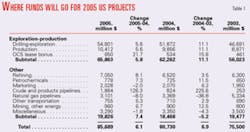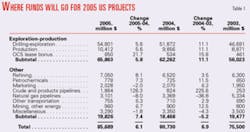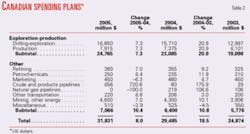Capital spending in the oil and gas industry this year will be strong but will not grow as much as it did a year ago.
With the robust oil prices of the past few years, investment in exploration and development might have been spurred more than it has been. But companies are using much of their cash flow to purchase shares of their stock, pay down debt, and increase stock dividends.
In the downstream segment, refining expenditures continue to climb as new sulfur restrictions take hold. Spending for marketing will subside from 2004, while construction of crude and product pipelines in the US and Canada will be up.
OGJ estimates that total US spending will be $85.7 billion vs. $80.7 billion last year and $75.5 billion in 2003.
In Canada, according to OGJ projections, total oil and gas spending will reach $31.8 billion, up from $29.5 billion in 2004 and $24.9 billion the prior year.
Exploration and production spending outside the US and Canada, according to surveys by financial analysts, also is expected to increase this year.
Crude, products market
Budgeting for 2005 took place in a period of strength in the industry's commodity and product markets.
The US wellhead price of crude oil last year averaged $36.75/bbl, up from an average of $27.56/bbl in 2003 and $22.51/bbl the prior year.
In its March Oil Market Report, the International Energy Agency raised its estimate for 2005 worldwide demand to 84.3 million b/d from the previous estimate of 84 million b/d. This implies an annual increase of 1.8 million b/d.
IEA cited three primary factors for the revision: extremely cold temperatures in key consuming areas in late February and early March, a stronger US economy and therefore more demand growth in the US than previously predicted, and stronger Chinese demand.
On concerns about supply in light of limited spare production and refining capacity, the price of crude for April delivery closed at a nominal record of $56.46/bbl on the New York Mercantile Exchange on Mar. 16, the same day OPEC agreed at a meeting in Iran to raise its output ceiling by 500,000 b/d.
Two days later the futures price of oil on the NYMEX set another record at $56.72/bbl.
This increase in official OPEC output, effective immediately, puts the organization's target at 27.5 million b/d, although "cheating" was already causing output to exceed this amount. In addition, OPEC announced at its meeting in Iran that it would raise its output ceiling by another 500,000 b/d should prices fail to subside before its next scheduled meeting in June.
Bill O'Grady, analyst with A.G. Edwards & Sons Inc., last month said that since crude and gasoline inventories in the US are plentiful and prices are strong the bullish market psychology likely needs some significant event to turn prices around.
O'Grady suggests that one such likely event is the end of additions to the Strategic Petroleum Reserve (SPR). With the US injecting about 1 million bbl into the SPR each week, the reserve should reach its 700 million bbl capacity before the fourth quarter of this year.
US gas market
The average US wellhead price of gas was $5.49/Mcf last year, up from $4.88/Mcf in 2003 and $2.95/Mcf the prior year.
US gas production declined in 2004, according to preliminary estimates. OGJ estimates that marketed production of gas totaled 19.5 tcf, down from 19.9 tcf in 2003 and 2002 and 20.6 tcf in 2001.
Last year's production decline was due to a busy hurricane season in the Gulf of Mexico, which hampered offshore production during the final 4 months. Although the amount of working gas in storage was at the top of the 5-year range, prices soared.
On Nov. 3, 2004, the price of gas on the NYMEX peaked, closing at $8.752/ MMbtu. A few trading sessions later, the price closed down more than $1 from that level, and for the last trading day of the year gas closed at $6.149/ MMbtu.
Demand for gas in the US declined last year to 22.28 MMcf from 22.38 MMcf in 2003 and 23 MMcf in 2002. In 2004, residential and commercial gas consumption declined from a year earlier, but the electric power sector used more gas.
US upstream spending
Exploration and production spending in the US will grow 6% this year, less than last year's growth of 11%. OGJ estimates that total upstream oil and gas spending in the US will reach nearly $66 billion this year.
These estimates are in part based on the number of wells forecast to be drilled (OGJ, Jan. 17, 2005, p. 33). Drilling and exploration expenditures this year will be $54.8 billion vs. $51.9 billion last year and $46.7 billion the prior year.
Geophysical and geological costs will account for $7.1 billion of this year's drilling and exploration total.
A barometer of activity, the Baker Hughes Inc. count of active rotary rigs averaged 1,192 last year, up from 1,032 the year before. And so far this year, the count is up further. The January average was 1,255, and the February rig count moved up to 1,276.
Production spending will grow in step with drilling and exploration and will total $10.4 billion this year.
OGJ estimates that companies will spend $650 million on bonus payments related to Outer Continental Shelf lease sales. There are four such sales scheduled to take place in 2005: one in Alaska and three in the Gulf of Mexico.
Last year there were only two Gulf of Mexico sales, and OCS bonus payments totaled $534 million. In 2003, one Alaska sale and three Gulf of Mexico sales garnered $461 million in OCS lease bonus payments.
Other US expenditures
Capital expenditures for all other oil and gas activities in the US will increase to $19.8 billion this year from $18.5 billion a year ago. In 2003, such spending totaled $19.5 billion. Refining, marketing, and pipeline construction are the major divisions in this category of spending.
Clean-fuels spending has dominated plans of most refiners recently. The maximum sulfur content for gasoline in the US will be 30 ppm, down from 90 ppm, beginning in June 2006, when the maximum diesel sulfur content will be lowered to 15 ppm from 500 ppm.
Refiner Valero Energy Corp. projects that its capital expenditures this year will be $1.8 billion, up from $1.6 billion last year. While Valero spent $315 million last year on Tier II investments to lower the amount of sulfur in gasoline, the company plans to ramp up such spending to $455 million this year.
Meanwhile, Dallas-based Holly Corp. plans to spend $52 million this year to bring its Navajo refinery in Artesia, NM, into compliance with ultralow-sulfur highway diesel regulations and expand capacity by 10,000 b/d to 85,000 b/sd.
ConocoPhillips plans to spend $1.3 billion in its US refining operations this year, $800 million of it for clean-fuels projects. A year earlier the company planned to spend a total of $900 million on US refining in 2004, with most of that going toward clean-fuels projects as well.
OGJ forecasts that total US refining capital expenditures this year will be $7.05 billion, an increase of 8%. This compares with a 3.5% increase last year.
Pipeline construction in the US this year will be strong, as activity picks up for crude and products lines but cools for gas lines.
Plans call for a total of 1,255 miles of crude and products lines to be constructed in the US this year (OGJ, Feb. 7, 2005, p. 57). The cost for these projects is $1.9 billion. This compares with $824 million in spending for such projects last year.
Gas pipeline construction in the US this year is planned at 2,076 miles, down from plans for 2,422 miles last year. Outlays for this year's gas lines will total $3.1 billion. Most of the planned lines will be larger than 30 in. diameter.
Spending for transportation equipment other than pipelines will grow to $755 million this year from $710 million last year and $690 million in 2003. Marketing outlays, which include gasoline stations and convenience stores, this year will decline only 2% to $2 billion following a 6% growth spurt last year. Capital spending for all other projects, including mining and miscellaneous expenses, will be unchanged at $4.25 billion this year.
Spending in Canada
In Canada, upstream expenditures will grow more than 7% this year, and all other outlays will increase more than 10%. In 2004, Canadian exploration, drilling, and production spending surged 21%, while downstream expenditures moved up almost 11%.
The Canadian Association of Petroleum Producers reported that in 2003 there were 17,796 well completions in Canada. OGJ estimates that the number climbed last year and will be up further this year.
Baker Hughes reported a small decline in the average number of rigs active in Canada to 369 last year from 372 in 2003. This year's count has started higher, though, with an average of 550 rigs in January and 593 in February.
Exploration and drilling outlays in Canada will total $16.9 billion this year, compared with $15.7 billion last year and $13 billion in 2003. Production spending will climb to $7.9 billion from nearly $7.4 billion last year.
Mining and other energy projects dominate downstream budgets in Canada. OGJ expects such outlays—which cover oil sands expenditures—to total $4.6 billion this year. This will be a 7% increase from last year.
Refinery capital spending in 2005 will also increase 7%. In 2004, these expenditures grew more than 9% to $355 million. Likewise, expenditures for petrochemical plants will increase 6.4% this year after rising almost 12% last year.
Pipeline construction this year in Canada will be strong for crude and product lines. Companies plan to lay 380 miles of those types of pipeline this year, on which spending will total an estimated $656 million. This is up from last year's plans for crude, product, and gas line construction of $299 million. OGJ's latest pipeline construction report found no plans for gas line construction in Canada this year.
Other transportation expenditures will increase to $220 million from $206 million, and miscellaneous outlays, including corporate expenses, will decline slightly to $510 million. Marketing outlays in Canada will return to 2003's level of $450 million from $480 million last year.
Global trends
Many US-based companies plan to increase capital expenditures for projects outside the US and Canada.
The most recent Lehman Bros. E&P spending survey indicates that such outlays will climb 4.5% this year (OGJ, Dec. 20, 2004, p. 28). That survey also ranked the key determinants of this year's spending, putting cash flow, prospect availability, and natural gas prices at the top of the list.
ConocoPhillips detailed its 2005 spending plans last December, revealing an increase from plans to spend $4.5 billion on global E&P in 2004.
For this year, ConocoPhillips budgeted $5.1 billion for worldwide E&P, with $1.4 billion allocated for projects in the North Sea and West Africa. The company will spend $900 million to develop projects in the Asia-Pacific region, and additional funds will go toward projects in Venezuela, the Middle East, northern Africa, Russia, and the Caspian Sea.
Outside the US, Marathon Oil Corp. plans to spend $706 million for production and $194 million for exploration and exploitation. This represents a 31% increase in production spending from a year earlier and a 5% decline in exploration and exploitation expenditures.
Marathon's key production investments outside the US are in Norway, where the company expects its Alvheim and Vilje developments to begin producing in 2007. Other areas where Marathon is investing in production growth and development projects are Russia, Ireland, and Equatorial Guinea.
Marathon budgeted $481 million for this year's integrated gas investments, with nearly all of it for the company's LNG project in Equatorial Guinea.
Marathon, which owns 75% of the terminal under construction, is a partner with the National Oil Co. of Equatorial Guinea in this project. First shipments of LNG from the terminal are scheduled for late 2007.
ChevronTexaco plans to spend $4.9 billion this year on E&P and global gas-related projects. This is up from $4.5 billion last year.
Peter Robertson, ChevronTexaco vice-chairman, said that the company plans to commercialize its international gas resource base with $400 million in capital expenditures this year going toward such projects in Australia, Angola, Nigeria, and Mexico, as well as the US.
ChevronTexaco's plans also call for spending $900 million on refining and marketing investments outside the US, compared with $600 million planned last year.


